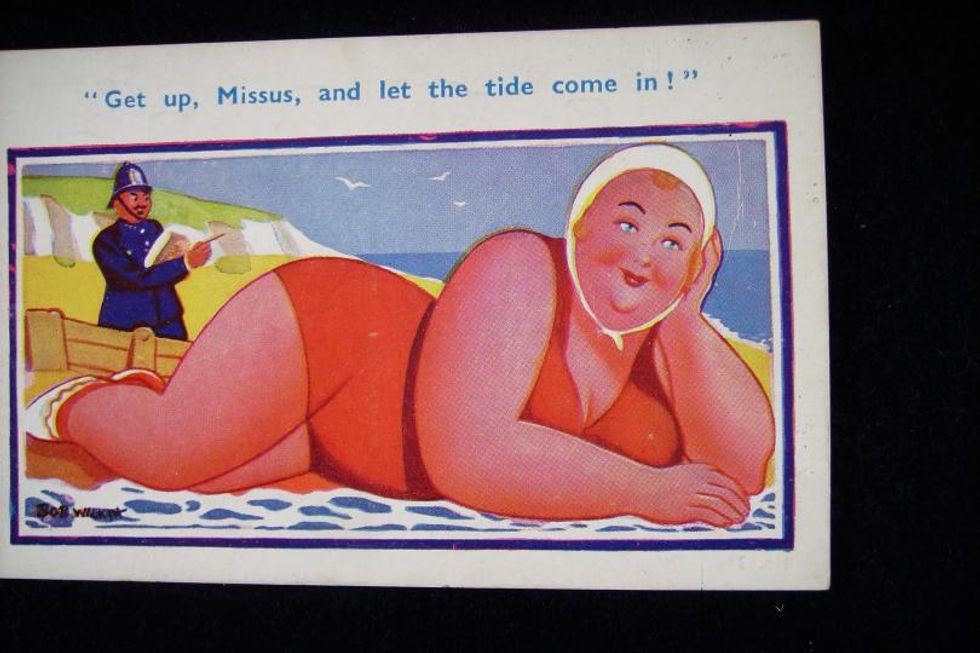From a young age we’re taught the need to fit. We’re conditioned to define things by what they look like and by their physicality or form. When we’re toddlers, we play matching games where we pair certain objects together based on their shapes—based on physical appearance. We assemble puzzles, learning how to identity when some pieces don’t fit and when others are just right.
I’ve never had an eating disorder—not technically. And yet I remember in third grade starting to look at the nutrition facts on the back of food packaging—Yoplait yogurt, candy bars, anything really. I’d climb onto my green and blue-speckled counter, grab a bag of Fritos and go straight for the total fat content. Somehow my brain told me it was fine, it was normal and I didn’t think twice about it.
There were certain days I remember standing barefoot in my kitchen, counting what I had eaten in the past hours on my fingers. I felt uneasiness in the pit of my stomach like hardened yoke at the bottom of a bowl you can’t scrape clean. Sometimes I would have a single strawberry shortcake flavored éclair ice cream bar for lunch (yes, I was very particular about my ice cream), would thrive off of the sugar until dinner when I’d realize I’d been hungry for hours.
Don’t get me wrong—I never starved myself. I never got to the point where I developed anorexia, bulimia or any severe eating disorders like that. I was horrified when I found out my celebrity idol at the time, Mary-Kate Olsen, had been extreme-dieting to lose weight. Before her eighteenth birthday, she was sent to a rehab facility for an eating disorder. Of course when I discovered the news, I turned to my diary—what else? An entry from July 18, 2004 read:
Whether I subconsciously knew better or whether I simply wasn’t interested in testing the boundaries of weight loss after awhile, I consider myself very lucky. Even still, I have distinct memories of my eating habits being disordered.
*
One Huffington Post article reported that in a survey taken by 9 and 10-year-old girls, 40% of them have tried to lose weight. Those first memories of body awareness and my tiptoe waltz with the idea of dieting and weight loss, were from when I was around that age. The study also showed that by age 13, 53% of American girls are “unhappy with their bodies.” By the age of 17, this grows to a disheartening 78%. Another article from Next Avenue found that 75% of women in the U.S. report “disordered” eating behaviors. One could argue that all women are uncomfortable with their bodies, that it’s normal to pick and pull at ourselves out of shame. But when did the body become something to hate? And more importantly—why?
Body shaming. It’s a relatively new term that has been circulating the Internet. It’s driven by cruelty and perhaps insecurity from the offense, like a big bully who won’t leave you alone on the playground. It targets the overweight, the underweight and everyone in between—women especially. But this concept has been around for longer than you’d think. Now we just have a name for it.
The first weight-loss drugs were introduced in 1920. Interestingly enough, according to AOL, the “Halo Effect” was a term first used in 1920, in which it was thought that physically attractive people are smarter, funnier and kinder than the “average person.” Sound familiar?
Even before 1920, the first diet books were published in the 19th century; however, there wasn’t the same obsession with slender, thin figures. Author Amy E. Farrell explained that in the 19th century, “there was a greater desire for a certain level of body fat; it demonstrated that one was fertile and hearty, neither starving nor a victim of the many wasting diseases that flourished in that time period.” Apparently, there was even a certain level of respect given to the “‘fat cat,’ the wealthy man whose girth demonstrated his prosperity.” However, once there were transformations in health care, work lives, and transportation, Farrell stated that it was not just the wealthy that put on the pounds, it was everyone. And this is when weight obsession really gained traction.
In an interview for the International Business Times, Farrell told a reporter that early signs of fat-shaming included the introduction of “fat women” postcards in the early 1900’s. “They were postcards people would pick up at tourist sites,” she said. “Instead of texting, they’d send postcards they bought at the corner pharmacy…[they] would show a fat butt, sometimes as a pincushion,” and poke fun.
*
Body shaming was everywhere growing up, draped over my childhood memories like a layer of filth. And the sad part is, it took me years to realize it. I was a gymnast for almost a decade and a half and it was there—in the chalky-aired facilities—that I witnessed such shaming the most. It was there where girls flipped and twisted and defied the laws Newton worked so hard to prove. And it was there where if you ever had any extra skin, any flab that jiggled while you flew through the air, everyone knew.
I had a coach for the later years of elementary school whose facial expressions were always stone cold. She reminded me of a stallion the way her straight, thick hair was always pulled into a long, curtain of black. She was cruel and always made you feel like you were never good enough. Because after all, in the sport of gymnastics, you’re chasing perfection in everything that you do. You must abide by the rules of perfection. But the problem is, this is an impossible goal. Even Newton knew that.
I remember there was one girl on my team who was heavier than the rest of us (keep in mind that we were eight, nine, and 10 and were curve-less, thin bodies). I was proud of my six pack and boyish biceps that of course, still fit into the confines of my tight long-sleeve competition leotard. I was petite, strong, yet graceful—maybe that’s why my coach gave me the easiest time out of everyone. But this girl had thighs that moved when she tumbled across the floor—god forbid your flesh rippled when you pounded on springs or mats, or when you turned and spiraled like a corkscrew in the air.
My coach would make this girl do extra conditioning, made her run stairs for 5, 10 minutes longer than the rest of us. She’d point at the lines on my teammate’s skin and bark at her that she was “too young for cellulite,” and “why doesn’t your mother care about the problem?” Problem. This girl, who had not even turned 10 years old yet, was being told that her weight was in the way and was no good. That she was no good.
*
The fat-shaming that has made itself a comfortable spot in the heart of our society is, some would argue, human nature. But how can we as humans allow ourselves to choose one body type over the other, let alone scrutinize each other for not being a certain shape? Why are we so fixed on thinness, slenderness and overall physical attractiveness? According to an article entitled, “Why Thin Will Always Be In,” we treasure that which are rarities. For example, “Diamonds, Picassos, or people with extraordinary sports ability tend to be more highly valued than things that are common. In our culture…the vast majority of people are overweight or obese.” Due to the fact that in today’s society, being overweight is average, “thinner people are by definition rarer, and therefore more in demand. And the fatter our country gets, the more valued thin people will be, based on body shape alone.” We are telling people to shrink themselves.
Our society has conditioned us to never be happy with the outlines of our figures. We are shamed into think we’re too big or too small and can never fit. But our bodies, their shapes, hold so much greatness within them. It’s quite obvious, but if you didn’t already know how truly amazing the human body is, here are a few, among hundreds, of striking facts. One BuzzFeed article reported the following. There is an estimated 60,000 miles of blood vessels in the human body. If that isn’t enough, we house living and dying things—we house the circle of life within the walls of our flesh. Every minute, 300 million cells in our bodies die, but they produce 300 billion new cells each day. Long story short, the Big Bang resulted in an incredible thing. Every element on Earth was formed at the heart of a star. So the elements in our bodies—hydrogen, nitrogen, etc.—are made of stardust. Literally. I guess the moral of the story here is that we truly are so much more than our shapes. We shine.























